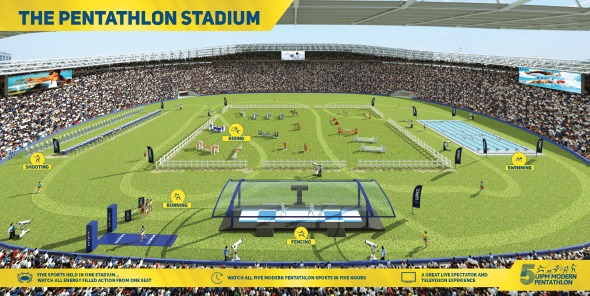Special Report: How the Pentathlon Stadium has changed the game for UIPM
August 8, 2016
Modern Pentathlon goes to the Olympics in Brazil, having finally dealt with one of the sport’s most difficult challenges – exposing its audience to all five sports on the same day.
The idea of a ‘Pentathlon Stadium’, is the latest innovation by Modern Pentathlon, after the successful implementation of environmentally and spectator friendly laser shooting & the combined event in London 2012 which resulted in the highest ever media interest at the Olympic Games, the Stadium concept came to fruition in 2013.
A spectator can now watch 5 disciplines in 5 hours with one ticket from one seat. This innovation will make its Olympic debut in Rio and will enhance the sport to the spectators and media.
Janusz Peciak is a former Modern Pentathlon Olympic (1976), and chairman of UIPM Technical Committee, he explains the benefits of the stadium idea.
“The Pentathlon Stadium is an initiative concept that is proving very successful for our sport. It allows the spectators to understood completely the concept of our multi-sport as they can follow all the action from one seat ,5 events in one sport session.”
“It allows them to follow our athletes as they swim, fence, ride, run and laser shoot all with one ticket and all under five hours. The ideal venue is a football or rugby stadium that allows for a temporary 25m/6 lane swimming pool to be installed.”
“As has been shown by spectators surveys taken at Olympic Games, those that have bought tickets not knowing the full aspects of Pentathlon have appreciated the diversity of our pentathletes and left after the competition keen to find out more about our amazing super athletes and our sport.”
Including swimming in the stadium as part of the event is perhaps the biggest logistical challenge, but Karen Myers, Event Director with Modern Pentathlon, explains that UIPM are adaptable when it comes to venues at major events.
She said: “If a swimming pool is located near to the ‘stadium’ that is acceptable to UIPM for its events in case a temporary pool is not possible in the stadium.”
“Regarding location of the venues, they must be easily accessible for the spectators by road and public transport. The host country also has to arrange 30 horses of good quality for the show jumping discipline and in some cases, temporary stabling will be required at the venue.”

UIPM organises 11 high level major events per year in Modern Pentathlon including a 4 editions of a World Cup Series and a Final, plus 3 World Championships Senior, Junior and Youth as well as our Champion of Champions event and sub-sports Championships include annually Biathle/Triathle World Championships and Laser-Run World Championship.
With so many events encompassing so many different sports how difficult is it for Modern Pentathlon to gain access to the various arenas and facilities they need?
Myers continues: “As UIPM does not ask or require dedicated venues for its sports, the availability of the venues when shared with other sports and events means careful planning in advance with regard to fixing the dates of our events. Additionally as an outdoor sport, the weather conditions also have to be taken into account.”
With the Games around the corner, Myers was keen to point out that Pentathlon events are planned well in advance in order to suit the needs of everyone involved and interested in the sport running up to and after the Games.
“Media attention (written and TV) is notably more focused on the World Cup Series and the Senior World Championships in an Olympic Year. Due to these factors, UIPM ensures that these events are hosted in cities with the necessary infrastructure to meet the additional requirements and managed by our most experienced National Federations.”
“Therefore, these events are awarded at latest 3 years in advance to ensure the organisers have enough time to put all the necessary procedures in place and to reserve the venues and accommodation.”

And have the planning methods and new ‘stadium’ concept been a success? Well Myers certainly thinks so:
“Audience reach is wider bringing in not only existing fans of pentathlon but also those of fencing, riding and athletics.”
“As has been shown by spectators surveys taken at Olympic Games, those that have bought tickets not knowing the full aspects of Pentathlon have appreciated the diversity of our pentathletes and left after the competition keen to find out more about our amazing super athletes and our sport.”
With just over a month to go until the Olympics, Modern Pentathlon are heading into Rio with high hopes that the Pentathlon Stadium concept could change the way the sport is seen by the world.
{jcomments on}



